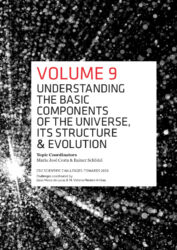Coordination: María José Costa; Rainer Schödel
Publication date: 2021
Language: English
Categories: Ciencia y Tecnología, Divulgación científica
Collection: CSIC Scientific Challenges : Towards 2030
Number of pages: 121
ISBN: 978-84-00-10754-3
eISBN: 978-84-00-10755-0
Publishing: house Madrid : Consejo Superior de Investigaciones Científicas, 2021
Reference CSIC: 13677
Other data: (CSIC Scientific Challenges : Towards 2030 ; vol. 9)
This is volume 9 of the 14 “CSIC White Papers” that define its strategy until 2030.
The book contains 10 challenges. The challenge #5 «FORMATION AND EVOLUTION OF GALAXIES AND LARGE STRUCTURES» has been coordinated by José Manuel Vílchez and J. Miguel Mas-Hesse (CAB), CSIC-INTA.
Other CAB researchers who have participated in this challenge are: Almudena Alonso-Herrero, Santiago Arribas, Miriam García, Jesús Maíz-Apellániz
The challenge #6 «UNDERSTANDING THE CYCLE OF MATTER IN THE UNIVERSE» has been coordinated by Francisco Najarro (CAB), CSIC-INTA, and Javier R. Goicoechea.
Other CAB researchers who have participated in this challenge are: Miriam García, Izaskun Jiménez-Serra, Ignacio Mendigutía, Carmen Sánchez-Contreras
Understanding the basic components of the Universe, its structure, and evolution is one of the noblest and most ambitious undertakings of humanity. The fundamental laws of nature are the basis of all technology. Finding and understanding them requires exploring both the elementary components of matter at the smallest scales and the observable Universe at the largest scales. Only through understanding the laws that dictated the first instances of the Universe will we be able to find the ultimate reason for its actual appearance and future fate. Challenges in physics are intimately associated with technological challenges for the design and building of telescopes, space missions or accelerators, reactor and underground experiments, as well as developments in mathematics. Their resolution requires a worldwide, transdisciplinary effort and the orchestrated involvement of researchers, engineers, and technicians. The challenges described here are fully aligned with the priorities identified in international and European strategies.







